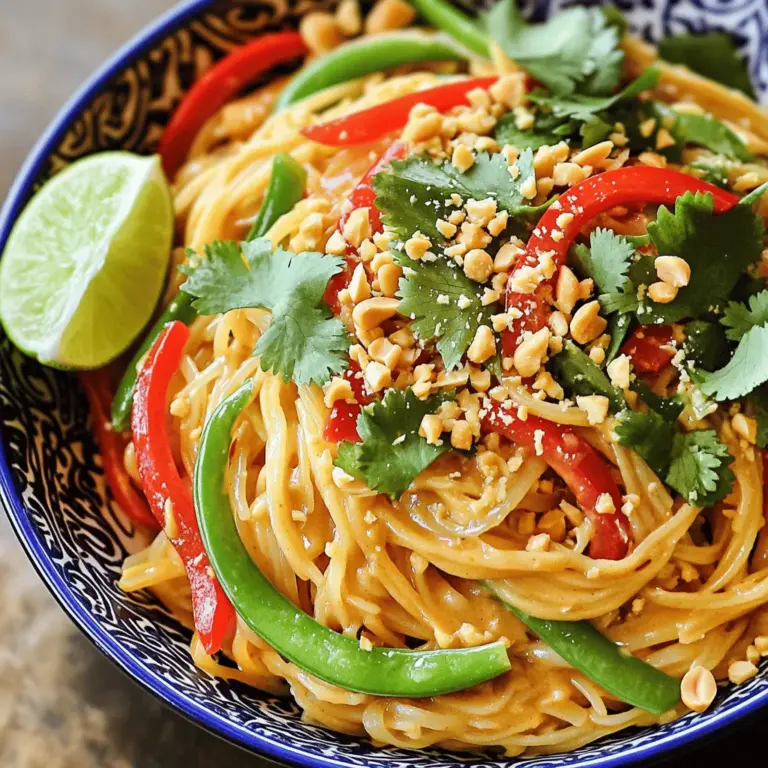Are you ready to spice up your dinner routine? My Spicy Thai Peanut Noodles offer bold flavors that will leave your taste buds dancing. With just a few simple ingredients, you can whip up a dish that’s not only fun to make but also incredibly satisfying. Let’s dive into this easy recipe and discover how to create a delicious meal that impresses every time!
Ingredients for Spicy Thai Peanut Noodles
Essential Ingredients
To create spicy Thai peanut noodles, gather these key ingredients:
- 8 oz rice noodles
- 1 cup peanut butter (creamy or chunky)
- 2 tablespoons soy sauce
- 2 tablespoons rice vinegar
- 2 tablespoons honey or maple syrup
- 2 tablespoons sesame oil
- 1 tablespoon Sriracha (adjust to taste)
- 1 red bell pepper, thinly sliced
- 1 cup snap peas, trimmed
- 2 green onions, chopped
- 1/4 cup cilantro, chopped
These ingredients bring bold flavors to your dish. The rice noodles serve as a soft base. Peanut butter adds creaminess and richness. Soy sauce and Sriracha give it that spicy kick.
Optional Garnishes
Add these garnishes to enhance your dish:
- Crushed peanuts
- Lime wedges
- Cilantro
Crushed peanuts provide crunch. Lime wedges add freshness and acidity. Cilantro gives a nice herbal note. Feel free to mix and match according to your taste!
Ingredient Substitutions
You can make this dish your own with these swaps:
- Use almond butter instead of peanut butter for a different flavor.
- For a vegan option, replace honey with maple syrup.
- Choose low-sodium soy sauce to cut back on salt.
These substitutions help you cater to dietary needs. They also allow you to experiment with flavors, making this dish unique. Enjoy the process of personalizing your spicy Thai peanut noodles!
Step-by-Step Instructions
Cooking the Noodles
Start by bringing a large pot of water to a boil. Once boiling, add the rice noodles. Cook them according to the package instructions, usually about 5 to 7 minutes. You want them to be al dente, meaning they should still have a slight bite. To check doneness, taste a noodle. If it’s ready, drain the noodles in a colander. Rinse them under cold water to stop the cooking process. This step keeps the noodles from getting mushy. Set the rinsed noodles aside while you prepare the sauce and veggies.
Preparing the Peanut Sauce
In a mixing bowl, combine the peanut butter, soy sauce, rice vinegar, honey or maple syrup, sesame oil, and Sriracha. Whisk them together until smooth. This sauce packs a punch! If the sauce is too thick, add a splash of water. Stir until you reach your desired consistency. Taste your sauce. If it needs more sweetness or heat, adjust with more honey or Sriracha. This balance is key to making the sauce shine.
Sautéing the Vegetables
Heat a large skillet or wok over medium heat. Add a drizzle of oil to the pan. Once hot, toss in the thinly sliced red bell pepper and snap peas. Stir-fry them for about 3 to 4 minutes. You want them tender yet crisp. This quick cooking keeps their bright colors and crunch. Choose your veggies based on what you love! Bell peppers and snap peas are great, but you can add others like carrots or broccoli.
Now you’re ready to mix everything together. Grab the noodles and pour in the peanut sauce. Toss until the noodles are evenly coated. Add the cooked veggies, and stir well. This dish is all about bold and rich flavors, making every bite count.
Tips & Tricks for Perfecting Your Dish
Common Mistakes to Avoid
Avoid overcooking your noodles. Cook them just until they are al dente. This keeps them firm and prevents mushiness. After cooking, rinse them under cold water. This stops the cooking process and keeps them from sticking together.
Next, watch your sauce. If it is too thick, it may not coat the noodles well. Add a splash of water to get the right consistency. If it is too thin, your dish may lack flavor. Aim for a creamy texture that clings to the noodles.
Flavor Enhancers
To boost flavor, try adding crushed red pepper or chili flakes for extra heat. You can also toss in some crunchy veggies like carrots or cabbage for added texture. For a fresh twist, serve with lime wedges. Squeezing fresh lime juice over the dish brightens the flavors and adds zest.
Cookware Recommendations
Use a large skillet or wok for sautéing. This allows for even cooking and plenty of space for your veggies. A non-stick pan works best to prevent sticking. For mixing the sauce, a medium bowl and a whisk will do the job well. These tools make blending your ingredients quick and easy.
Follow these tips to elevate your Spicy Thai Peanut Noodles and impress your guests.

Variations of Spicy Thai Peanut Noodles
Protein Additions
You can add protein to your Spicy Thai Peanut Noodles for a hearty meal. Shrimp is a great choice. It cooks quickly and adds a nice flavor. Just sauté the shrimp for 2-3 minutes until pink. Chicken works well too. Use thin strips and cook until no longer pink. For a plant-based option, try tofu. Press the tofu to remove moisture, then cube it. Sauté until golden for a perfect texture.
Seasonal Vegetable Ideas
Choosing seasonal vegetables can enhance your dish. In spring, add fresh asparagus or snap peas for crunch. In summer, zucchini or bell peppers shine. For fall, consider adding butternut squash or carrots for sweetness. In winter, try broccoli or bok choy. Adjust cooking times based on the vegetable. Softer veggies need less time, while denser ones need a bit more. Stir-fry until they are tender but still crisp.
Dietary Variations
You can adapt this recipe to fit different diets. For gluten-free, use rice noodles and tamari instead of soy sauce. If you want a vegan version, swap honey for maple syrup. For nut-free options, try sun butter or tahini in place of peanut butter. Each variation still brings delicious flavors, so everyone can enjoy this meal!
Storage Information
Best Practices for Storing Leftovers
To keep your Spicy Thai Peanut Noodles fresh, store them in airtight containers. Glass containers work best, as they do not absorb odors. If you have extra sauce, store it separately. This keeps the noodles from getting soggy. Portion out what you need to avoid wasting food.
Reheating Tips
When you’re ready to enjoy leftovers, you can reheat them on the stovetop or in the microwave. For the stovetop, add a splash of water and heat over low. This helps keep the noodles from drying out. In the microwave, heat in short bursts. Stir often to ensure even warming.
Shelf Life
You can keep Spicy Thai Peanut Noodles in the fridge for about 3 to 5 days. Always check for signs of spoilage. If the noodles look slimy or smell off, it’s best to throw them away. Keeping track of dates helps you enjoy this dish at its best.
FAQs About Spicy Thai Peanut Noodles
How Do You Make Homemade Peanut Sauce?
To make homemade peanut sauce, gather these ingredients: peanut butter, soy sauce, rice vinegar, honey or maple syrup, sesame oil, and Sriracha. Mix them in a bowl until smooth. If your sauce is thick, add a splash of water. This keeps it creamy and easy to pour. Each ingredient adds a unique taste. The peanut butter gives richness. The soy sauce adds salt. The vinegar brings tang. Honey balances the heat from Sriracha. You can adjust the heat based on your taste, too.
Can I Use Different Types of Noodles?
Yes, you can use different types of noodles! Rice noodles are traditional, but you can swap them for others. Try egg noodles or whole wheat noodles for a different flavor. Gluten-free options are also available, like soba or zucchini noodles. Just note that cooking times may vary. Always check the package for instructions. This flexibility allows you to customize the dish based on your preference.
What Is the Origin of Spicy Thai Peanut Noodles?
Spicy Thai peanut noodles come from Thai cuisine. They blend Asian flavors, especially from Thailand. The dish highlights peanuts, common in Thai cooking. Street vendors often serve it with various spices and herbs. It reflects the love for bold flavors and quick meals in Thai culture. This dish has grown in popularity worldwide.
Is This Dish Gluten-Free?
Yes, this dish can be gluten-free! Use gluten-free soy sauce, often labeled tamari. Rice noodles are naturally gluten-free, making them a great choice. Always check labels on your ingredients to avoid hidden gluten. With these simple swaps, you can enjoy this spicy delight without worries. This makes it perfect for those with gluten sensitivities.
Spicy Thai peanut noodles are a tasty dish you can easily make at home. We covered the key ingredients, from rice noodles to optional garnishes. I shared tips for cooking, making sauce, and sautéing veggies to get it just right. You also learned what mistakes to avoid and how to adapt the recipe for different diets. Remember to store leftovers wisely for the best taste. Now you can create this dish confidently and enjoy it in many ways!
- Spicy Thai Peanut Noodles

